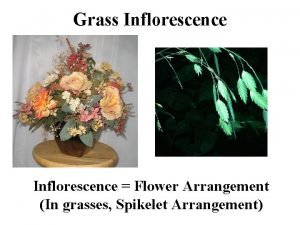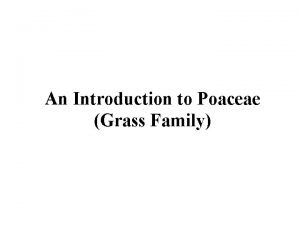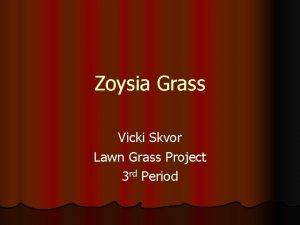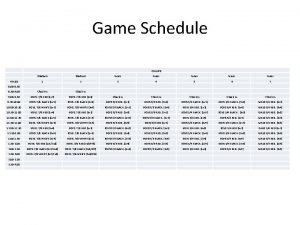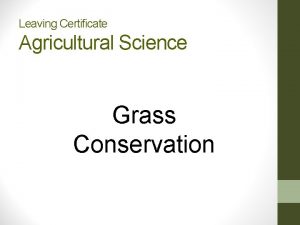LESSON SEVENTEEN Grass Seedings Types of Grass Seedings









- Slides: 9

LESSON SEVENTEEN: Grass Seedings

Types of Grass Seedings There a number of different types of seedings including plantings for erosion control, wildlife habitat, forage production, and restoration of prairies. The main differences among the types of seedings are: Erosion Control: Goal is a community with structure that provides excellent erosion control but these species and varieties may not necessarily have good forage value. Wildlife Habitat: Goal often is a low successional community with a wide variety of forbs and a small number of grasses. Some wildlife plantings are for pollinator habitat and include a large diversity of forbs to ensure that nectar producing plants are flowering throughout the entire growing season. Pasture Planting: Goal is a community that provides forage (usually cool-season, introduced grasses and legumes) during a time frame when forage is limited on native rangeland. Range Planting: Goal is to return cropland to grass (but may be implemented on depleted rangeland) with a plant community that is dominated by native grasses. Prairie Restoration: Goal is to return cropland or degraded rangeland to a plant community as close as possible to the reference plant community. The seeding contains numerous species (40+). Photo: Range Seeding in Lincoln, County. The planting consists of Sand little bluestem, Indiangrass, sand lovegrass, switchgrass, prairie sandreed, blue grama, western wheatgrass, purple prairie clover, upright coneflower, blackeyed Susan, leadplant and shell-leaf penstemon.

Species and Variety Selection For a successful seeding the appropriate species and variety should be seeded. Species selection should be based on ecological sites. Plants that occur in the geographical area and on the ecological site(s) within that area should be seeded. A number of improved varieties have been developed for many Nebraska grass species. These varieties have diverse genetic traits that help individual plants grow on specific soils and sites. The improved varieties have better vigor, productivity, longevity, and resistance to disease or pests within their adapted areas. A list of adapted grasses and varieties appropriate for Nebraska grass seedings on different ecological sites can be found in the University of Nebraska. Lincoln publication Certified Perennial Grass Varieties Recommended for Nebraska – EC-120. Certified seed is seed harvested from improved varieties. Certified seed meets minimum standards for genetic purity, germination and mechanical purity. Certified seed is inspected and is of known origin and performance. The Nebraska Crop Improvement Association is the entity that certifies seed in Nebraska. Pollinator planting, Perkins County. 12 native forbs were planted with a minimal amount of grasses. The most successful forbs in this portion of the planting are purple prairie clover, blanket flower, and fringed sagewort.

How are Grass Seed Varieties Developed ? Grass seed varieties are developed by plant breeders. The plant breeder organization may be USDA Plant Materials Centers and/or Agricultural Research Service Stations, or private seed companies. Plant breeders start development of a grass seed variety with seed collections. Seed is collected from across a wide geographic area from grass plants that exhibit the desired trait(s). These seeds are grown in plots with each individual collection being grown separately. Seed from best performing collections are seeded in additional plots to increase the amount of seed. When enough seed from the high performing seed lots is available, the performance of the seed is evaluated in field trials located throughout the region. After several years of trials, the collection that performs the best, based on the desired characteristic, is selected for release. The variety is usually named for the area of the original seed collection. For example, Barton western wheatgrass is a variety developed from a seed collection from Walnut Creek in Barton County, Kansas.

How Much Seed Should Be Planted? The amount needed depends upon the purpose of the seeding. The amount of seed needed for a successful planting is expressed on a pure, live seed basis. Pure live seed refers to the purity and germination of the seed. Purity – After grass seed is harvested it is cleaned to remove pieces of stems, leaves, and other materials. Many seeds, like Indiangrass or sand bluestem seeds, have fluffy structures which makes removing all non-seed material difficult resulting in low purity. Switchgrass seed is easy to clean and usually has high purity. Germination – In some grasses, a relatively high percentage of grass seed is not viable and will not germinate. Prairie sandreed typically has a lower germination rate than switchgrass. In order to plant the desired amount of seed, the volume of seed planted must be adjusted to account for its purity and germination. The Natural Resources Conservation Service recommendation for range seedings is that grass seed be planted at a rate of 20 PLS (pure live seeds) per square foot. Photo: Range planting with big bluestem, little bluestem, switchgrass, Indiangrass, green needlegrass, western wheatgrass, sideoats grama, and prairie junegrass and several forbs.

Calculating the Amount of Seed Needed Grass seeding rates are based on the amount of pure, live seeds in a pound of grass seed (PLS pounds). But grass seed is usually sold in bulk pounds. How can a landowner determine how many bulk pounds to buy to have the correct amount of PLS pounds? Two calculations need to be made. 1. Calculate the % PLS of the bulk pounds % PLS = (germination x purity) / 100 2. Calculate the bulk pounds needed. PLS # needed = Acres x PLS lbs. /ac Bulk #needed = (PLS pounds needed / %PLS) * 100 Example: Rancher Smith wants to seed a 15 acre field to grass. 6 PLS pounds/acre are needed to achieve 20 PLS/sq. ft. The seed lot has 85% germination and 60% purity. How much bulk seed is needed to seed the 15 acre field? 1. (85 x 60) / 100 = 51% purity 2. (6 PLS lbs. /ac x 15 ac) = 90 PLS lbs. needed 3. (90 PLS lbs. / 60) * 100 = 150 bulk pounds needed

Steps for a Successful Seeding 1. Prevent herbicide damage. If seeding cropland, make sure there is no herbicide carryover. Check the label of herbicides used to make sure the carry-over period is over. 2. Seed into a firm, weed-free seedbed. If the seedbed is firm, you will barely leave a footprint in the soil. When seeding into cropland, seeding into standing cover reduces weed competition, gives a firm seed bed, and the standing cover provides a positive micro-climate for the seedlings. The preferred cover is grain or forage sorghum stubble. 3. Use a grassland drill with depth bands. A grassland drill can handle the fluffy seeds and can control planting depth which should be between ¼ and ½ inch. 4. Use the appropriate origin, species, variety and quality of seed. 5. Use the appropriate PLS seeding rate for the purpose of the seeding. 6. Seed at the proper time. In Nebraska, a late fall seeding (November 1 until the ground freezes) or early spring seeding (after the ground thaws until May 15) is recommended. 7. Fertilizer is not recommended for native species during establishment. 8. Control weeds. Some weeds help provide shade and a favorable micro-climate, but too many weeds compete for water and space. Annual grasses (cheatgrass, crabgrass, foxtail) are more competitive than broadleaf plants like sunflower and marestail. In some soils kochia and Russian thistle may need to be controlled. 9. Don’t graze until the stand is established or the seedlings will be harmed. The

Activities and Review ■ Calculate the number of PLS (pure live seed) pounds needed with different combinations of purity and germination in bulk seed. ■ Take a look at UN-L Perennial Grass Variety Guide and determine the recommended varieties for your area. Research the varieties and identify their source. ■ Kansas State University: Establishing Natived Grasses ■ Certified Perennial Grass Varieties Recommended for Nebraska – EC-120.

END OF LESSON SEVENTEEN





